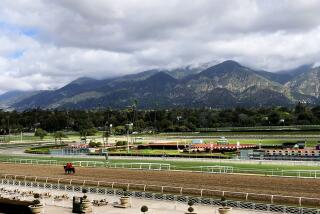COMMENTARY : Drug-Test Procedure Needs Some Revising
- Share via
When it comes to cocaine testing, California racing officials can’t seem to get it right the first time.
Earlier this year, the issue wasn’t whether jockeys were sniffing the drug, it was whether trainers were giving it to their horses. Horse racing officials accused Wayne Lukas and Laz Barrera, two of the sport’s best known trainers, and four lesser-known trainers of just that.
Now, months later, five of the six cases have evaporated, and the sixth, against Roger Stein, also appears to be desolving. The state admitted having lost data in its testing laboratory and on a refrigerated railroad car when many samples accidentally broke.
Now, Pat Valenzuela’s drug test is negative one day, but positive a few days later. Valenzuela, who despite at least three stays at rehabilitation clinics, has never received a suspension because of drug use--a record that is expected to end today.
Valenzuela could be in a position to challenge another ruling by the stewards because of the latest foul-up.
“Verbally, the report was negative,” one of the Oak Tree stewards said. “But when the written report came in, it was positive. There was a mistake made in communications.”
The process is involved. The urine sample is sent from the track to the laboratory, in Tarzana. The laboratory runs the test and sends the result to the racing board in Sacramento. The board relays the result to a field agent at the track. The agent then notifies the stewards.
“Even though there was a contradiction, the important thing is that Pat did not do any riding before the correct test result was obtained,” steward Pete Pedersen said.
But the stewards got lucky. It was possible that Valenzuela could have been riding before they obtained the revised result.
The process for testing horses is just as intricate, but it is less likely that a contaminated horse will run another race before the chain of checkpoints is completed.
With jockeys, it’s different. Jockeys caught under the influence are capable of imperiling other riders, who are trying to navigate skittish horses running as fast as 35 miles per hour. That’s a more important issue than the one related to giving owners, trainers and the betting public a bum run for their money.
At Santa Anita Thursday, there was more talk about Valenzuela than horses, and there were wild stories about what the stewards will do. One was that Valenzuela was going to get a year’s suspension.
The ruling can’t be nearly that severe, because technically this is his first offense.
The stewards could be responsible for that. Although they have tested him hundreds of times, the method has been scattershot. Even though Valenzuela missed two consecutive days earlier this season, he was not tested until after he was a no-show to ride favored Hawkster in a $500,000 race.
Because of the second reading on Valenzuela’s first test, conversations with the stewards this week got confusing. When they said he had tested positive, it was assumed that they were referring to his second test. Only a chance question resulted in the revelation that the first test wasn’t negative after all.
There’s a need to test properly, but test swiftly. It shouldn’t be that complicated. Since the safety of other jockeys is at stake, couldn’t the chain of action be revised? Couldn’t the stewards be notified first if there’s a positive, so they can flag the offender for an immediate hearing?
The California Horse Racing Board is getting around to some of these problems. At a meeting of its medication committee next month, one of the items to be discussed is the horse-testing laboratory’s obligation “to produce timely reports.”
Timeliness with the testing of jockeys is even more important.
More to Read
Go beyond the scoreboard
Get the latest on L.A.'s teams in the daily Sports Report newsletter.
You may occasionally receive promotional content from the Los Angeles Times.










